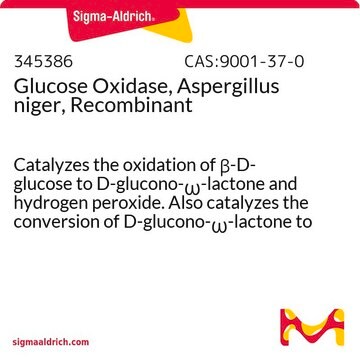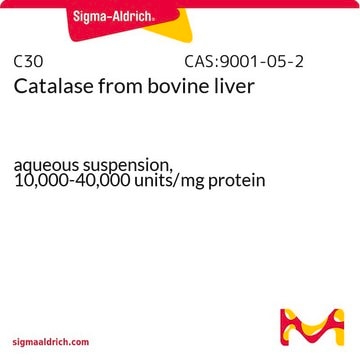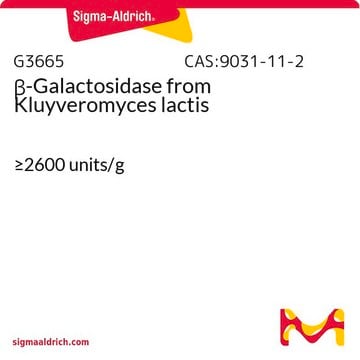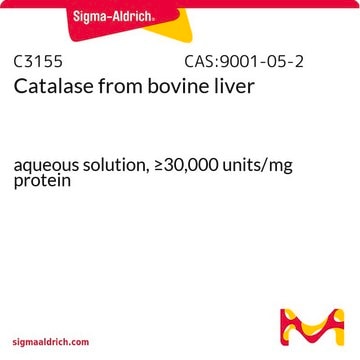G6766
Glucose Oxidase from Aspergillus niger
2,000-10,000 units/g solid (without added oxygen)
Synonym(s):
β-D-Glucose:oxygen 1-oxidoreductase, G.Od., GOx
Sign Into View Organizational & Contract Pricing
All Photos(1)
About This Item
Recommended Products
form
powder
specific activity
2,000-10,000 units/g solid (without added oxygen)
mol wt
160 kDa
storage temp.
−20°C
InChI
1S/C6H12O6/c7-1-2-3(8)4(9)5(10)6(11)12-2/h2-11H,1H2/t2-,3-,4+,5-,6-/m1/s1
InChI key
WQZGKKKJIJFFOK-VFUOTHLCSA-N
Looking for similar products? Visit Product Comparison Guide
General description
Molecular Weight: 160 kDa (gel filtration)
pI: 4.2
Extinction coefficient: E1% = 16.7 (280 nm)
Glucose oxidase from Aspergillus niger is a dimer consisting of 2 equal subunits with a molecular mass of 80 kDa each. Each subunit contains one flavin adenine dinulceotide moiety and one iron. The enzyme is a glycoprotein containing ~16% neutral sugar and 2% amino sugars. The enzyme also contains 3 cysteine residues and 8 potential sites for N-linked glycosylation.
Glucose oxidase is capable of oxidizing D-aldohexoses, monodeoxy-D-glucoses, and methyl-D-glucoses at varying rates.
The pH optimum for glucose oxidase is 5.5, while it has a broad activity range of pH 4-7. Glucose oxidase is specific for β-D-glucose with a KM of 33-110 mM.
Glucose oxidase does not require any activators, but it is inhibited by Ag+, Hg2+, Cu2+, phenylmercuric acetate, and p-chloromercuribenzoate. It is not inhibited by the nonmetallic SH reagents: N-ethylmaleimide, iodoacetate, and iodoacetamide.
Glucose oxidase can be utilized in the enzymatic determination of D-glucose in solution. As glucose oxidase oxidizes β-D-glucose to D-gluconolactate and hydrogen peroxide, horseradish peroxidase is often used as the coupling enzyme for glucose determination. Although glucose oxidase is specific for β-D-glucose, solutions of D-glucose can be quantified as α-D-glucose will mutorotate to β-D-glucose as the β-D-glucose is consumed by the enzymatic reaction.
pI: 4.2
Extinction coefficient: E1% = 16.7 (280 nm)
Glucose oxidase from Aspergillus niger is a dimer consisting of 2 equal subunits with a molecular mass of 80 kDa each. Each subunit contains one flavin adenine dinulceotide moiety and one iron. The enzyme is a glycoprotein containing ~16% neutral sugar and 2% amino sugars. The enzyme also contains 3 cysteine residues and 8 potential sites for N-linked glycosylation.
Glucose oxidase is capable of oxidizing D-aldohexoses, monodeoxy-D-glucoses, and methyl-D-glucoses at varying rates.
The pH optimum for glucose oxidase is 5.5, while it has a broad activity range of pH 4-7. Glucose oxidase is specific for β-D-glucose with a KM of 33-110 mM.
Glucose oxidase does not require any activators, but it is inhibited by Ag+, Hg2+, Cu2+, phenylmercuric acetate, and p-chloromercuribenzoate. It is not inhibited by the nonmetallic SH reagents: N-ethylmaleimide, iodoacetate, and iodoacetamide.
Glucose oxidase can be utilized in the enzymatic determination of D-glucose in solution. As glucose oxidase oxidizes β-D-glucose to D-gluconolactate and hydrogen peroxide, horseradish peroxidase is often used as the coupling enzyme for glucose determination. Although glucose oxidase is specific for β-D-glucose, solutions of D-glucose can be quantified as α-D-glucose will mutorotate to β-D-glucose as the β-D-glucose is consumed by the enzymatic reaction.
Application
Glucose oxidase is widely used in the food and pharmaceutical industries as well as a major component of glucose biosensors.
Biochem/physiol Actions
Glucose oxidase catalyses the oxidation of β-d-glucose to d-glucono-β-lactone and hydrogen peroxide, with molecular oxygen as an electron acceptor.
Quality
Crude. May contain catalase, amylase, maltase, glycogenase, invertase, and galactose oxidase.
Unit Definition
One unit will oxidize 1.0 μmole of β-D-glucose to D-gluconolactone and H2O2 per min at pH 5.1 at 35 °C, equivalent to an O2 uptake of 22.4 μl per min. If the reaction mixture is saturated with oxygen, the activity may increase by up to 100%.
Analysis Note
Protein determined by biuret.
Signal Word
Danger
Hazard Statements
Precautionary Statements
Hazard Classifications
Resp. Sens. 1
Storage Class Code
11 - Combustible Solids
WGK
WGK 1
Personal Protective Equipment
dust mask type N95 (US), Eyeshields, Gloves
Choose from one of the most recent versions:
Already Own This Product?
Find documentation for the products that you have recently purchased in the Document Library.
Customers Also Viewed
Feng Jia et al.
Langmuir : the ACS journal of surfaces and colloids, 28(50), 17389-17395 (2012-11-23)
To mimic the structure and functionality of multienzyme complexes, which are widely present in Nature, Pluronic-based micelles were designed to colocalize multiple enzymes. To stabilize the micelles as well as to enable characterization of single enzyme immobilization and multienzyme colocalization
Christian N Kotanen et al.
Talanta, 103, 228-235 (2012-12-04)
Fabrication of an enzyme amperometric biosensor for glucose via electropolymerization of pyrrole in the presence of glucose oxidase onto a hydrogel coated platinum electrode is hereby established as a viable biotransducer fabrication method. Platinum micro- (φ=25 μm) and macro- (φ=100
Guangqing Xu et al.
Analytica chimica acta, 755, 100-107 (2012-11-14)
A novel glucose biosensor, based on the modification of well-aligned polypyrrole nanowires array (PPyNWA) with Pt nanoparticles (PtNPs) and subsequent surface adsorption of glucose oxidase (GOx), is described. The distinct differences in the electrochemical properties of PPyNWA-GOx, PPyNWA-PtNPs, and PPyNWA-PtNPs-GOx
Fernanda C P F Sales et al.
Lab on a chip, 13(3), 468-474 (2012-12-18)
An intravenous implantable glucose/dioxygen hybrid enzyme-Pt micro-biofuel cell (BFC) was investigated. In this miniaturized BFC, a flexible carbon fiber (FCF) microelectrode modified with neutral red redox mediator and glucose oxidase was used as the bioanode, and an FCF modified with
Wen-Jing Cheng et al.
Clinica chimica acta; international journal of clinical chemistry, 415, 152-157 (2012-10-24)
Glucose oxidase biosensors are used in self-monitoring blood glucose concentrations. The capillary blood glucose quantitation requires a calibration curve. Due to the limitation in obtaining calibration curve from capillary blood, an alternate approach by using venous blood for neonatal measurement
Our team of scientists has experience in all areas of research including Life Science, Material Science, Chemical Synthesis, Chromatography, Analytical and many others.
Contact Technical Service









